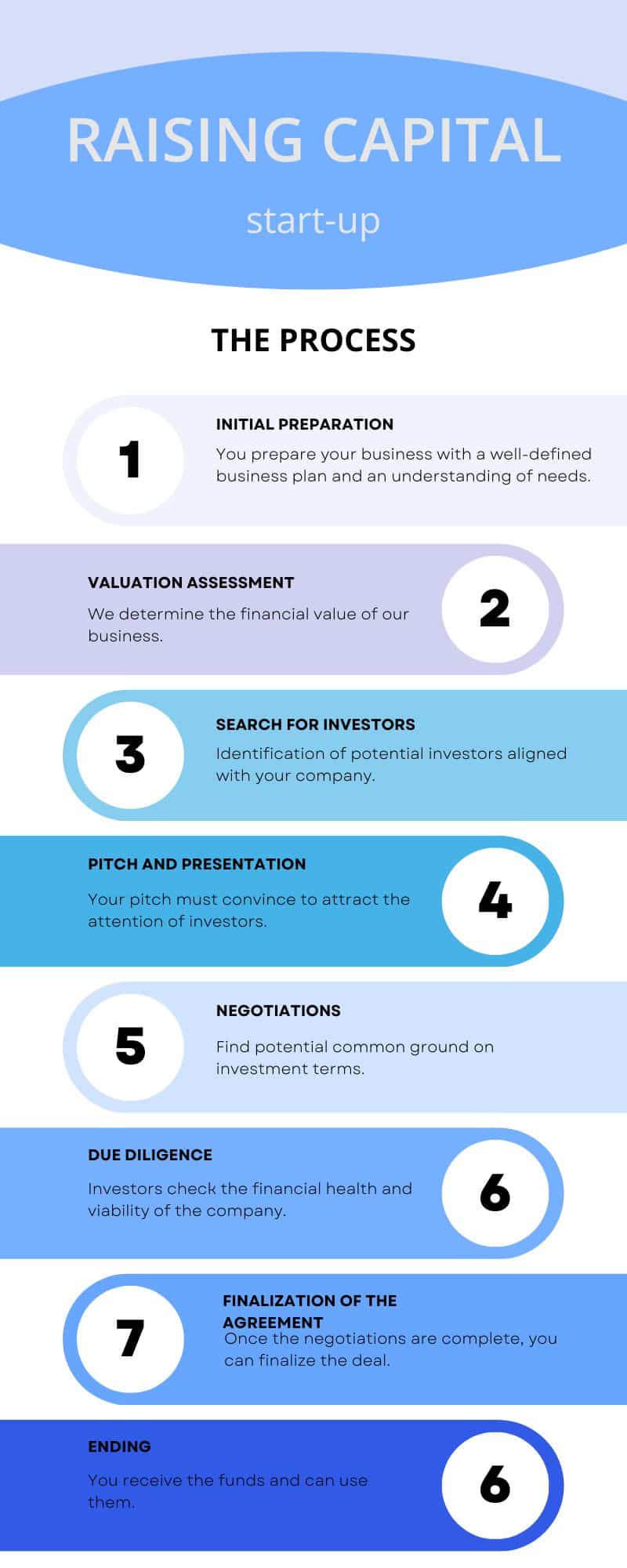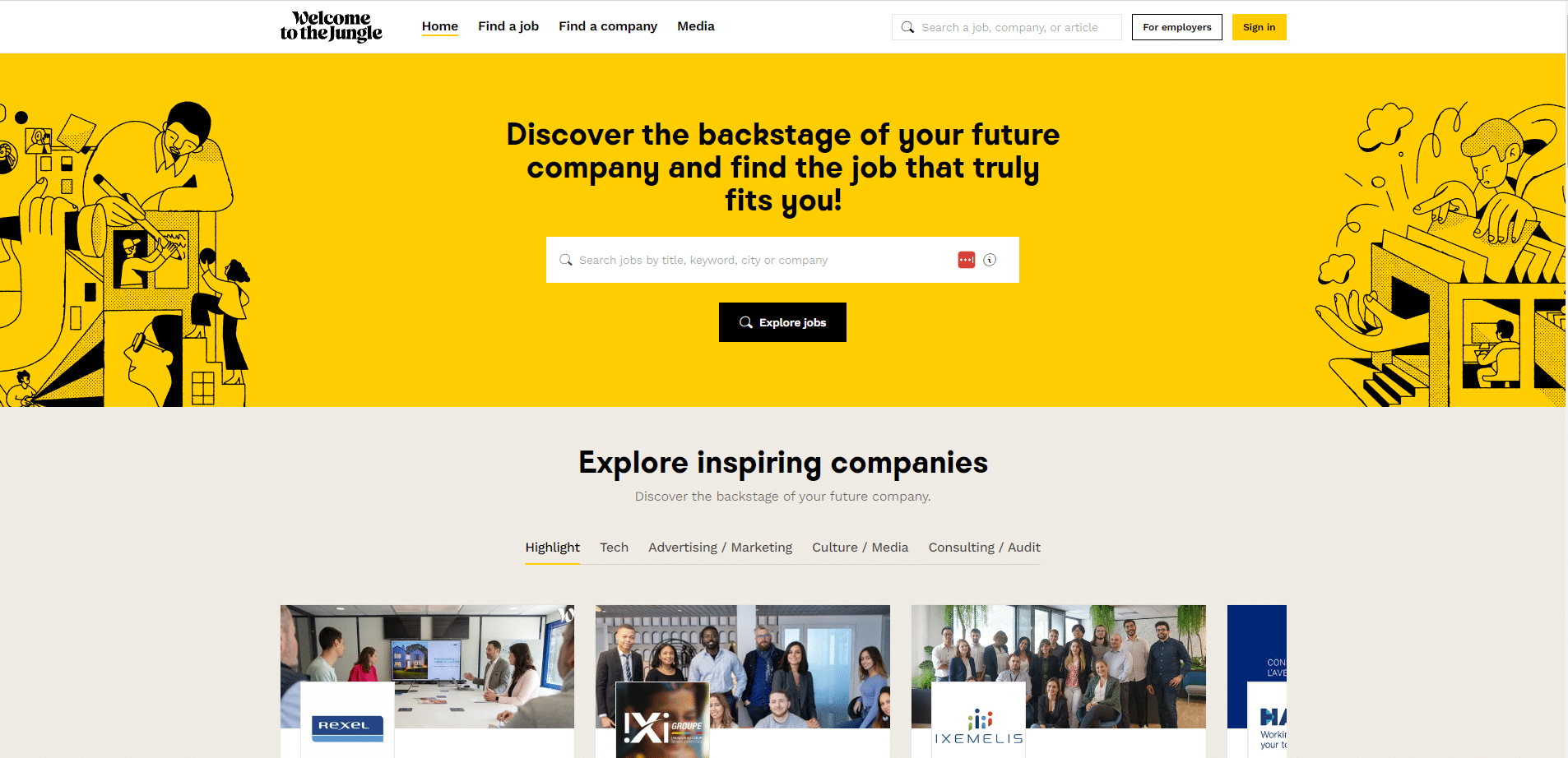Today, we’re going to find out how young companies raise the capital they need to write their financial success. You’ve got it, we’re going to talk about how to raise capital. And we’re off! Of course, get ready for a little surprise 😉.
On the agenda for this article
- ➡️ How to raise capital: Definition.
- ➡️ The process.
- ➡️ Interview.
- ➡️ Fundraisers to remember.
How to raise capital for business: Definition
Before immersing ourselves 🤿 fully in the subject, let’s first look at the definition of these terms.
Fundraising, in general terms, refers to the process by which a business or organization seeks funding 💰 or financial capital from investors, lenders or donors to support its activities, expansion or projects.
In the context of start-ups and the world of entrepreneurship, fundraising refers to obtaining external finance to develop a young company.
There are several common methods for raising funds. Let’s take a look at them now.
Fundraising for business:Venture capital
Venture capitalists provide funds to start-ups in exchange for an equity stake in the company.
Venture capital is often abbreviated to VC. It is a type of business financing where investors, called “venture capitalists” or “venture capitalists”, provide funds to start-ups and growth companies in exchange for an equity stake in the company.
They generally invest in companies with high growth potential 📈 but which may also involve a high level of risk.
| Aspect | Description |
| Objective | To support companies with high growth potential, particularly start-ups. |
| Equity financing | Investment of funds in exchange for shares or equity in the company. |
| Risk and return | High risk, with the potential for significant returns if successful. |
| Involvement of investors | Provide advice, resources and expertise in addition to funding. |
| Financing phases | Involved at different stages of the company’s development (seed, start-up, growth, IPO). |
| Exit | Gains are realised when the company is sold or floated on the stock market. |
Participative financing (or crowdfunding campaign)
Companies solicit small financial contributions from a large number of people via online crowdfunding platforms 🖥️. This form of financing has become increasingly popular in recent years. It offers new funding opportunities for a variety of projects and businesses.
| Aspect | Description |
| Types of crowdfunding |
Donation: contributions with no expectation of financial return. – Rewards: non-financial rewards in exchange for support. – Business loan: loan of money with future repayment. – Investment: investment in exchange for shares or equity.
|
| Crowdfunding platforms |
Online platforms enable project owners to create participatory funding campaigns.
|
| Varied projects |
Used to fund a wide variety of projects, including product launches, films, community projects, businesses, etc.
|
| Risk sharing and rewards |
Funding is distributed among many contributors, reducing dependence on a single investor.
|
| Visibility and marketing | Opportunity to promote the project, attract media attention and build a fan base. |
| Regulations | Regulations vary from country to country, with specific laws governing crowdfunding. |
Debt financing
This is a fund-raising mechanism. A business or organisation borrows money from lenders, usually in the form of bank loans 💳, bond issues or financing obtained from private investors. The company has an obligation to repay the amount borrowed, often with interest, over a defined period. There are several methods of debt financing, such as:
- Bank loans 💰.
- Bonds.
- Equity loans.
- Lines of credit.
Loans are often secured by collateral, such as real estate 🏢, equipment or business assets. In the event of default, the lender can seize these assets to recover its claim.
| Aspect | Description |
| Types of debt financing | Bank loans – Bonds – Equity loans – Lines of credit |
| Interest and repayment terms |
Companies pay interest on the amount borrowed and repay in accordance with the terms of the contract.
|
| Securing the loan |
Loans are often secured by collateral, such as real estate or company assets.
|
| Benefits |
Quick access to cash – Maintain control of the business – Deduct interest as a tax expense.
|
| Disadvantages |
Repayment with interest – Risk of financial burden – Consequences of non-repayment.
|
| Types of company |
Used by companies of all sizes, including small businesses, listed companies and not-for-profit organisations.
|
Seed capital
Seeding is also known as Seed funding 🌱. This is a crucial stage in the funding cycle of start-ups. It is the very first funding a start-up obtains to launch its activities, develop a prototype or conduct market research.
Sources of seed funding can include:
- Personal savings.
- Angel investors.
- Competitions 🖊️.
The aim is to turn a promising idea into a working business.
| Aspect | Description |
| Definition of seed funding | First stage of funding for start-ups, providing capital for the initial launch. |
| Sources of funding |
Includes founders‘ personal savings, angel investors, grants, etc.
|
| Business angels | Business angels invest their own money in exchange for an equity stake. |
| Objectives of seed funding |
Transform an idea into a functioning business, demonstrate a viable business model, attract customers and develop a growth strategy.
|
| Size of investment | The amounts invested are modest compared with the later stages of financing. |
| Associated risks | High-risk stage with a high failure rate. |
| Progression to other stages of financing | Once successful, the seed stage can lead to subsequent financing, such as venture capital. |
| The importance of preparation | Solid preparation, including a business plan, is essential to attract investors. |
Grants and competitions
These are sums of money 💸 or financial benefits provided by governments, non-profit organisations to support:
- Projects.
- Activities.
- Or specific initiatives.
This is a type of non-repayable grant. This means that recipients have no obligation to repay the funds received 🤩.
| Aspect | Description |
| Purpose of grants | To support specific projects, activities or initiatives with no obligation to repay. |
| Sources of funding | Governments, international organisations, private companies, philanthropic foundations, etc. |
| Types of grant | Governmental – Private – International. |
| Application and compliance | Applicants submit detailed applications and must comply with strict rules. |
| Fields of application | Research, education, environment, health, technology, economic development, etc. |
| Advantages and disadvantages |
Advantages: non-repayable funding; Disadvantages: competitiveness, administrative follow-up, strict conditions.
|
Seed fundraising
In the context of fundraising, the “seed” phase 🌱 refers to the first funding stage that a start-up goes through to obtain funds. It is typically the first step after initial funding from the company’s founders or other close investors 💓.
The “seed” phase is the very first round of funding a start-up has access to. At this stage, the start-up may still be at the product design, preliminary development or market research stage.
Investments in this phase are generally modest compared with later rounds of funding. The amounts raised vary considerably depending on the nature of the company and its specific needs.
Investors may be business angels, friends 🧑🏾❤️🧑🏻, family members or venture capital funds specialising in early rounds.
These funds are used for essential needs such as product development, market research, etc…
Fundraising Series A B C
Series A, series B and series C financing rounds are key stages in a start-up’s fund-raising process. Each of these stages represents a phase in the company’s development and growth. They are characterised by larger financing amounts and higher performance requirements.
Series A fundraising
Series A is generally the first round of institutional funding for a start-up, following the seed phase. At this stage, the start-up has already validated its concept, may have developed a prototype or launched a minimum viable product (MVP) and has acquired a defined quantity of users ✅.

The amount of funding in a Series A varies considerably, but can range from a few million to around ten million dollars.
Investors in this series are generally venture capital funds and institutional investors. They look for start-ups that have demonstrated their potential for growth and profitability.
Series B fundraising
Series B is the next round of funding after series A. Typically, the start-up has a proven track record of steady growth, a solid customer base and predictable future profitability.
Funding amounts are generally higher than in Series A and can range from several tens of millions of dollars to over a hundred million.
Series B investors are generally the same as Series A investors, as well as private equity funds and private equity firms.
These funds are generally used for accelerated growth, expansion into new markets, acquisition of competitors or investment in research and development.
Series C fundraising
Series C is the third 🟢 major round of funding after Series B. At this stage, the start-up is generally at an advanced stage of development, has a solid customer base, is on track to become profitable, and may even consider an IPO in the medium term.
The amounts of funding in this round are even larger than in previous rounds, and can exceed several hundred million dollars.
Investors often include private equity firms, institutional investors and sometimes venture capitalists.
These funds are used for massive growth, global expansion 🌍, market consolidation, strategic acquisitions, or to prepare the company for a potential IPO.
How to raise capital for business: the process
As you can imagine, the process is complex and requires meticulous preparation. Let’s take a look at the different stages involved in raising funds for a start-up.

Developing the stages 👇.
1. Initial preparation
This phase involves preparing your business for fundraising. You need to make sure you have a good team 💪 a well-defined business plan and a clear understanding of your funding needs.
There are, of course, several stages to this preparation:
- Business analysis: you start with a thorough assessment of your business. You will examine
- ➡️ Your business model.
- ➡️ Your finances.
- ➡️ Your performance indicators.
- ➡️ Your positioning…
- Funding requirements: Here you will really identify why you need funding.
- Financial objectives: Determine the financial objectives of the fund-raising. How much money do you hope to raise?
2. Valuation assessment
It is essential to determine the value of your business. This includes its financial value, before you start looking for investors. And, this is known as a pre-money valuation and is the process of estimating the value of your business before you raise funds.
This value is important because it determines the share of ownership that investors will receive in exchange ♻️ for their investment. A realistic valuation is crucial to attracting investors, as it reflects the true value of your business and sets clear expectations for all parties involved.
3. Investor searches
Identify potential investors who are aligned with your business and objectives. This may include angel investors, venture capital funds, private equity firms..
As you can imagine, this is an essential step. Before you start, you need to be 💡 clear about your funding needs. Work out how much money you need, what stage of development you’re at, and what you can offer in return.
Of course, you’ll also need to create a solid investment plan that explains how you’ll use the funds you’re seeking. Highlight your business model, your growth strategy and your financial projections.
To find your investors, build a network, you can try LinkedIn, use online platforms or attend networking events.
4. Pitch and presentation
When we talk about pitching, we’re not talking about that delicious little bun 🥖… No, the pitch is a short, punchy presentation.
Prepare a convincing pitch that highlights your company, its value, its market, its team and its growth plan. This presentation is extremely crucial to attracting the attention of investors.
You must succeed in capturing the audience’s attention. You can use storytelling, an interesting statistic or a question.
There are stages in your presentation, and here they are 👇:
- Introduction.
- Problem: Explicitly identify the problem your company solves. Investors need to understand why your solution is needed.
- Solution ✅: Present your product as the solution. Highlight what makes your solution unique.
- Target market 🎯: Describe who your customers are, show the size of the market and its growth potential.
- Business model : Explain how you make money.
- Traction : Highlight your company’s key achievements.
5. Negotiations
Discussions 👄 and negotiations with potential investors are a key part 🔑 of the process. It is important to find common ground on the terms of the investment.
To succeed in negotiations, it is essential to explicitly define objectives, set priorities and prepare by gathering information about the other party. Active listening and constructive communication are key skills, as they enable you to understand the needs and concerns of the other party.
Making strategic concessions is often necessary, while seeking win-win solutions that create value for all parties. Clear, legally binding documentation is essential to record the terms of the agreement. Time management is an important consideration, as negotiations can drag on over time ⏳.
6. How to raise capital: Due diligence
Due diligence is a process of thorough examination and investigation that companies, investors and other parties carry out before engaging in commercial transactions, such as mergers and acquisitions, investments, partnerships or contractual agreements.
The aim of due diligence is to gather accurate and reliable information 📄 about a company. The aim? To assess the risks, benefits, value and legality of the transaction. It typically includes examining the company’s finances, assets, contracts, governance, human resources, regulatory compliance, pending litigation and other relevant aspects.
Investors conduct extensive due diligence to assess your company’s financial health, viability and potential. Be prepared to provide detailed information.
7. Finalizing the deal
This is the stage where all parties involved in a business transaction commit 🫱🏼🫲🏼 to the agreed terms and conditions. This is a critical moment which occurs after the negotiations have been successfully concluded and the details of the agreement have been agreed.
Once the negotiations are complete and due diligence is satisfied, you can finalise the agreement and obtain the funds.
8. Closing
And, this is the final phase, we review the signatures 🖋️ on the final documents such as contracts, agreements..
The fundraising is complete when the funds are transferred and the legal agreements are signed. From then on, you can use the funds to develop your business in accordance with the established plan.
It is essential to monitor and respect the terms of the agreement, so that all parties comply and the objectives set are achieved.
Now that we’ve seen the definition and the process, why don’t we ask someone who has actually raised money to give us the information we need?
Fundraising for business: Interview with Tom Benattar
We put a series of questions to Tom Benattar, who raised funds for his company PixelMe.

I should point out that the fund-raising I’m about to talk about was for my company before PixelMe. Which I sold a year
ago
Can you introduce yourself? Introduce your company? And tell us what it does?
You’ve successfully raised funds. Can you explain to us what fund-raising is? How would you explain it to an audience new to the subject? And why is it important for businesses?
Fund-raising involves giving a portion of your capital in exchange for a sum of money to investors, with the aim of enabling your company to grow faster.
For a novice, it’s simply a case of granting part of your company’s shares to an investor in exchange for money that the investor injects into the company. The aim is for the investor to recoup 10 to 100 times his initial investment after five years.
This is only important if the company is experiencing real growth, which requires a lot of capital to go faster and conquer a market while waiting to find a point of equilibrium.
What types of investors are generally involved in raising funds for start-ups, and what are their motivations?
There are two types of investor. Firstly, there are the business angels 👼 entrepreneurs who have sold their companies or done very well and who want to give a little back, tax-free, and hope to make a handsome capital gain.
Then there are the professional investors (VCs), who are financed by massive corporates. For them, it’s simple: they know that for every 10 companies, there’s one that’s going to make x100 of the investment, so they’ll be able to return a large multiple of the money to the corporates.
What are the main criteria that investors look at when considering financing a start-up?
It really depends on the stage (seed, series A, B, C…). In our case, the seed stage, investors will mainly be looking at the team and the market. Is this team capable of delivering something incredible over five years in this market?
What I’m talking about are financing rounds with implicit, codified rules. A seed round, for example, will raise between 500K and 2 million euros, with a valuation of between 1 and 5 million euros. Series A, B and C are the subsequent rounds that a start-up will go on to finance itself.
What are the advantages and disadvantages of raising funds from investors, compared to financing on your own or from other sources?
Advantages: money available before you have a turnover or a lot of turnover, recruiting en masse and quickly to go faster, having access to a somewhat closed network.
An investor gives money in exchange for shares in a company.
They aim to eventually recoup a multiple of their investment (10 to 100 times, for example). The problem with this is that the sale price of the company has to be very high for the investor to get what he wants.
Whereas an entrepreneur who has not raised any money will be able to sell his business for a few thousand or even millions of euros and will be very happy to do so.
Disadvantages: loss of autonomy, having to be accountable and, above all, what most entrepreneurs forget is that a company that raises nothing more than a seed of 1 million will have a valuation of 4 to 5 million. This means that, at the very least, the VC will be expecting an exit of 20 to 50 million. The entrepreneur, on the other hand, can become rich by selling his company for 5 million.
How to raise capital: examples to remember
We’re now going to talk about those companies that have managed to stand out from the crowd with their fundraising for business.
Fundraising for business: Uber

You’re probably familiar with Uber. Yes, we’re talking about the mobility technology company. It was founded in 2009 and offers a mobile app 📱 that connects passengers looking for a ride with available drivers. Uber’s service is primarily focused on car transportation, although the company has expanded its offering to other modes of transport, such as:
- Bicycles.
- Electric scooters.
- Meal delivery via Uber Eats.
Now that we know what it is, let’s take a look at its fundraising, which is one of the most remarkable in start-up history 🌠.
When it launched in 2009, founders Travis Kalanick and Garrett Camp initially self-financed their business. However, to accelerate growth, they approached venture capitalists. In 2010, Uber raised $1.25 million in venture capital funding.
With this initial funding, Uber was able to expand rapidly in many US cities and internationally. The ride-sharing model was innovative and attracted a great deal of interest.
In 2011, Uber raised $37 million in its Series B funding round, led by Menlo Ventures. This round was critical to the company’s international expansion.
Over the years, Uber has completed several rounds of funding, with investors including Google Ventures, Benchmark and others. The company has continued to expand its global reach and diversify its services, including UberX, UberEATS and UberPool.
After amassing billions in private funding, Uber finally went public 💰 in 2019. However, its IPO was marred by questions about its valuation and financial losses.
How to raise capital: Welcome to the Jungle

Welcome to the Jungle is a recruitment and content platform for businesses and job seekers.
It was founded in 2015 by Jérémy Clédat and Bertrand Uzee.
The company has raised several rounds of funding to support its expansion and the development of its platform. Three fundraisings since 2015 – pretty strong, isn’t it?
The first fundraising, in 2018, the platform managed to raise €7 million, and with the aim of increasing its reputation and brand. In 2023, the French company managed to raise €50 million.
This third round of funding was made possible by their partners:
- Revaia.
- XAnge.
- Bpifrance.
- Blisce/.
- Cipio Partners.
- ADP Group.
- Kotogri.
- RAISE Sherpas.
This funding will enable the company to raise their profile, as they plan to expand internationally, particularly in the United States.
Airbnb : How to raise capital

A company you probably know has also raised funds. That’s right, we’re talking about Airbnb. This online platform that lets individuals rent out short-term accommodation was founded in 2008 by Brian Chesky, Joe Gebbia and Nathan Blecharczyk.
The company has experienced exceptional growth, but here is the story of their fundraising.
When it was set up, it was launched with limited financial resources. The founders even sold cereal 🥣 to raise initial funds. It was in 2009 that Airbnb completed its first Series A funding round raising around $7.2 million from investors including Sequoia Capital.
With the funds raised, it was able to expand its activities internationally, increasing its presence in many cities around the world.
Over the years, the company has raised several additional rounds of funding, including Series B, C and D financings raising hundreds of millions of dollars.
After years of development and fundraising, Airbnb finally completed its initial public offering 💰 (IPO) in December 2020. This step was a key moment in the company’s history, allowing it to become a listed company.
Conclusion of the article
As you know, all good things must come to an end. And this article on raising start-up funds is one of them. We’ve covered concepts such as:
- ➡️ The definition of fundraising.
- ➡️ The process.
- ➡️ Interview.
- ➡️ Fundraisers to remember.
FAQ about how to raise capital
We wouldn’t go and leave you so abruptly without giving you a few notions surrounding the subject we’ve been talking about today. Come on, let’s have a look 👇.
What are the consequences of raising funds for a start-up?
It has significant consequences for a start-up. It can have a major impact on its development, growth, governance and operations.
There are advantages and disadvantages, here they are.
- Access to capital: you have immediate access to significant financial resources.
- Validation: The involvement of professional investors is often seen as an external validation of the company’s viability.
- Networking: Investors can often provide valuable contacts, advice and networking opportunities.
- Resources: Investors can provide additional resources, such as skills, sector expertise and tools.
- Visibility: Successful fundraising can generate media attention, which can raise the profile of the start-up and attract the attention of other investors.
- Dilution: In return for investment, investors typically acquire a share of ownership in the company, which can dilute the founders’ stake.
- Pressure: Investors have expectations in terms of returns and profitability, which can put pressure on the start-up.
- Financial management: Financial management becomes increasingly complex as the start-up has more stakeholders to cater for.
- Time and cost: The fundraising process can be lengthy and costly in terms of time and resources, with the need to negotiate the terms of the deal.
- Dependency: A start-up that raises funds can become dependent on investors for its future growth, which can limit its decision-making autonomy.
As you might expect, that’s the end of our article, but you now have a solid grounding in how to raise capital. 🚀









